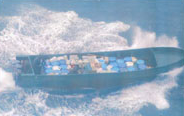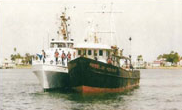A Model for Success in the Drug War
By Kelly J. Thomas, J.D.

On 3/18/07, the Coast Guard, in conjunction with the Panama Express Strike Force, seized 42,845 pounds of cocaine—a record seizure—from the freighter Gatun.
In the war against drugs, law enforcement officers at all levels face very well organized, corrupt, and dangerous criminals. Everyone, from the honest citizen to the government official, wants to see success in this difficult battle.
Over the past 10 years, the operation Panama Express has resulted in the seizure of over 500 tons of cocaine worth an estimated $10 billion. Authorities have arrested more than 2,000 international drug traffickers and transporters, mostly Colombians. Additionally, pending capture at open sea, transporters have dropped to the bottom of the Pacific Ocean another 391 tons of cocaine worth another $7 billion. These statistics demonstrate the success of this Organized Crime Drug Enforcement Task Force (OCDETF).
Joint Efforts
Created in 1982, OCDETFs combine the resources of federal, state, and local law enforcement agencies to combat the wave of drug trafficking and money laundering affecting the United States. The recently created OCDETF strike forces have authorization to collocate and commingle federal and state agencies to disrupt and dismantle drug organizations designated as consolidated priority organizational targets (CPOTs) and their drug-trafficking and transportation affiliates. The task and strike forces constitute the centerpieces of the U.S. attorney general’s war on drugs, and they now are supplemented with an OCDETF fusion center designed to gather, analyze, and store drug-related intelligence.
Drug War
The face of Colombian international drug smuggling has changed dramatically over the past 10 years. In the 1990s, 10 major Colombian cartels headquartered in Medellin and Cali coordinated over 80 percent of the cocaine reaching major markets.1 The cartel structure approximated a pyramid with the leader employing several hundred employees who manufactured cocaine, secured and transported it, and laundered the illicit proceeds.

Special Agent Thomas serves in the FBI’s Tampa, Florida, office.
In the late 1990s, officials from Panama Express and various federal agencies in New York, Miami, and other cities indicted the leadership in all of the controlling cartels. With the granting of extraditions by the Colombian government, the powerful cartels slowly started to fade, and myriad smaller bosses and drug-trafficking/transportation organizations (DTOs) grew to take their place. Unfortunately, the flow of cocaine rarely lessened because of the astronomical profits available to those in control. Now, each segment of the business is compartmentalized with cocaine owners hiring and sharing independent transporters for the drug treks to Mexico.
Additionally, the face of international drug smuggling has changed in other ways, especially in the modes of cocaine transportation. In the 1980s and 1990s, a principal mode of moving bulk cocaine (1 ton or more) was via Colombian fishing vessels that averaged 65 to 80 feet in length and generally carried 5 to 10 tons of product. These vessels traveled north from Colombia to several hundred miles off the coast of Mexico and transferred the drugs to Mexican fishing vessels.
After numerous successful interdictions of the slow fishing vessels in the early 2000s, the cocaine transporters supplemented their arsenal with go-fast boats similar to American “cigarette” boats; they were 40-feet long with four outboard engines and capable of transporting 2 to 3 tons of drugs. The U.S. Navy and Coast Guard responded with aerial force against these speedy targets, reducing this method of transport.
The traffickers and transporters shifted gears again. Starting in approximately 2005, the DTOs built self-propelled semisubmersible (SPSS) vessels and sent between 3 and 8 tons of cocaine on each trip. These vessels generally were 50-feet long with only 1 foot of a small port area above water. Panama Express made its first seizure of an SPSS in 2005.
Panama Express
Operation Panama Express started in 1995 with an FBI/ DEA investigation of three suspicious bank accounts in Naples, Florida. These accounts and many more in Panama belonged to Colombian cocaine transportation boss Jose Castrillon Henao. That investigation led to the indictment in Tampa, Florida, of Castrillon and more than 2 dozen cocaine transporters working in the eastern Pacific Ocean.
“Federal, state, and local law enforcement agencies face as tough an enemy as any in the battle against international drug smugglers.”
Successes in the Pacific Ocean
| Year | Vessels | Arrests | Kilos of Cocaine Seized |
| 2000 | 3 FVs, 7 GFs | 46 | 23,960 |
| 2001 | 2 FVs, 7 GFs | 47 | 12,955 |
| 2002 | 5 FVs, 11 GFs | 75 | 35,446 |
| 2003 | 8 FVs, 10 GFs | 103 | 25,748 |
| 2004 | 10 FVs, 13 GFs | 131 | 58,997 |
| 2005 | 11 FVs, 12 GFs, 1 SPSS | 138 | 50,994 |
| 2006 | 11 FVs, 17 GFs, 1 SPSS | 127 | 45,907 |
| 2007 | 12 FVs, 19 GFs, 6 SPSSs | 115 | 46,114 |
| 2008 | 5 FVs, 9 GFs, 6 SPSSs | 90 | 32,834 |
| 2009 | 3 FVs, 11 GFs, 11 SPSSs | 95 | 23,018 |
FV: Fishing vessels, GF: Go-fast boats, SPSS: Self-propelled semisubmersible vessels
This table does not represent scuttled loads, total loads seized in the Caribbean by spin-off investigations, or loads and arrestees submitted to foreign governments for prosecution.
Instead of viewing the indictment as a goal or fruition, Panama Express personnel used it as the genesis of a broad attack against the Colombian cocaine maritime transportation industry. Beginning in late 1999, convicted defendants were given the opportunity and the resources to develop evidence for historical cases and recruit sources for current, actionable intelligence on cocaine transportation operations launching from Colombia to Mexico. ICE, Coast Guard, and DOD agents and analysts joined Panama Express to work the cases jointly. In February 2000, the Colombian fishing vessel Rebelde was the first seizure, with a cargo of 4.5 tons of cocaine worth $67,500,000 ($15,000 per kilo).
Starting in 2000, Panama Express, along with the DOD Joint Interagency Task Force South (JITFS), has had great success, as illustrated by the chart, which also reflects the changing face of international drug smuggling in the eastern Pacific: the interdiction of Colombian fishing vessels led to the DTOs using go-fast vessels, and then, as U.S. successes mounted against this method, the smugglers built the SPSS vessels to avoid detection. Over time, U.S. maritime enforcement has adapted and increased its interdictions of SPSS vessels, which travel 80 to 90 percent below the sea surface and have become the transportation mode of choice for drug lords.2 For continued success, agencies must remain vigilant for new and novel smuggling methods.
Panama Express also uses a secondary tool: strategic indictments and arrests of high-level bosses, supervisors, or coordinators of the seized loads represented in the chart. As of January 2010, over 100 DTO managers have been indicted; arrested, primarily in Colombia; and extradited to the United States to face stiff sentences. Some of the highest-level cartel bosses, including Joaquin Mario Valencia-Trujillo, are serving lengthy U.S. prison sentences for their roles in sending hundreds of loads of cocaine from Colombia to Mexico for transshipment to the United States. Valencia-Trujillo, a former principal of the famed Cali Cartel, was sentenced to 40 years’ imprisonment and ordered to forfeit $110,000,000 in illicit proceeds. Panama Express and DOJ forwarded the U.S. forfeiture judgment to Colombia, which facilitated the seizure of tens of millions of dollars worth of Valencia-Trujillo’s assets.
Suggested Approaches
Some of the procedures and methods used by Panama Express can be considered for use by other strike forces, task forces, and drug-interdiction teams in their endeavors against international drug smuggling. In maintaining the high level of seizures and indictments over the past 10 years, FBI, DEA, ICE, Coast Guard, and JIATF personnel have learned many hard lessons. Some practices have proven significant in the accomplishments by Panama Express.
“Everyone...wants to see success in this difficult battle.”
- Eliminate agency turf battles by sharing all responsibilities and successes. For example, assign one agent from each organization to each case to work jointly toward fruition.
- Identify and target support elements for narco-trafficking organizations. Instead of focusing on an entire DTO, requiring years of investigation, task forces can have great success by targeting transportation. For instance, Mexican border smuggling could be exploited with a focus on the trucking industry.
- Develop human sources within the selected support element at all levels, including those at the lowest tier who have access to potential intelligence—even small pieces of the overall puzzle. Sufficiently pay the human sources to offset the extreme risks they take to assist law enforcement. Search for funding from nontraditional sources (e.g., Congress, U.S. executive agencies, military entities).
- Maintain a long-term strategy and always prioritize protection of human sources and confidential procedures over a short-term gain/ seizure.
- Seek out assistant U.S. attorneys and prosecutors who agree with the big picture of long-term strategies and provide reasonable incentives for cooperating defendants. Valuable and trusted cooperators must receive sufficient sentence consideration and other benefits to commit to long-term assistance to U.S. law enforcement.
- At inception, conduct meetings with the highest regional managers of each agency and commit all agreements to writing for division of resources, funding, and personnel. Early agreements are essential for long-term success and elimination of chronic turf battles prevalent among agencies.
- Schedule weekly all-hands meetings to share intelligence, successes, and planning. Develop close, professional relationships within each agency to develop integrated teams.
October 18, 2007 - Eastern Pacific, 59 bales

September 13, 2008 - Eastern Pacific, 237 bales

FV Rebelde, February 16, 2000 - Eastern Pacific, almost 5 tons

Conclusion
Panama Express personnel consider their endeavor a war. Federal, state, and local law enforcement agencies face as tough an enemy as any in the battle against international drug smugglers. These criminals are well-financed, corrupt, and deadly.
In The Art of War, Sun Tzu explains that waging a successful war requires planning; employing an adaptive strategy; identifying the enemy’s weak points; and using spies, or informants. Antidrug task forces must do the same and, if they consider it appropriate, use the listed suggested practices. The most effective strikes against drug smugglers will require exceptional cooperation among officers, agents, managers, and prosecutors.
Endnotes
1 Sidney Jay Zabludoff, “Colombian Narcotics Organizations as Business Enterprises,” Transnational Organized Crime 3 (Summer 1997): 23.
2 “Semi-Subs, Used to Carry Drugs, May Be Outlawed,” Tampa Tribune, June 27, 2008, p. 3.
